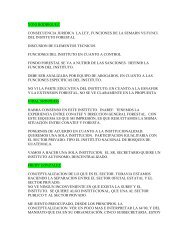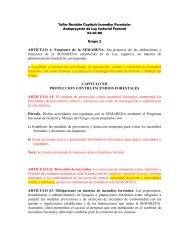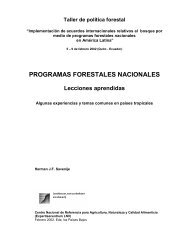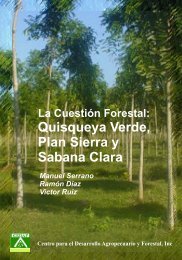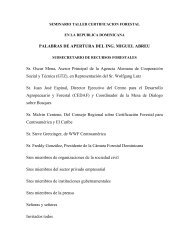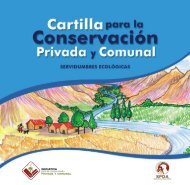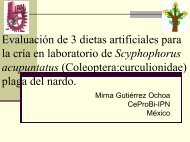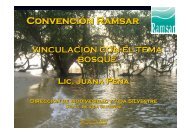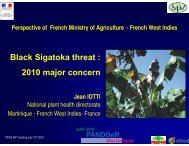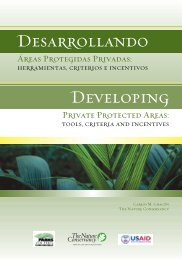Sapodilla (Manilkara zapota ) and Caimito ... - CEDAF
Sapodilla (Manilkara zapota ) and Caimito ... - CEDAF
Sapodilla (Manilkara zapota ) and Caimito ... - CEDAF
You also want an ePaper? Increase the reach of your titles
YUMPU automatically turns print PDFs into web optimized ePapers that Google loves.
Collecting Sapotes (Pouteria spp.), <strong>Sapodilla</strong><br />
(<strong>Manilkara</strong> <strong>zapota</strong>) <strong>and</strong> <strong>Caimito</strong> (Chrysophyllum<br />
cainito) on the Pacific Coast of Costa Rica <strong>and</strong><br />
Nicaragua<br />
Richard J. Campbell, Ph.D.<br />
Senior Curator of Tropical Fruit<br />
Gary Zill, Juan Carlos Herrera<br />
Campo Verde de la Familia, Costa Rica
<strong>Caimito</strong>, Chrysophyllum cainito<br />
<strong>Sapodilla</strong>, <strong>Manilkara</strong> <strong>zapota</strong><br />
Sapotes, Pouteria spp.
Local markets, subsistence <strong>and</strong> small farmers, key in local<br />
economies <strong>and</strong> regional stability.
Potential: Fresh fruit, products, local to international appeal, novel<br />
new markets.
Obstacles: Genetic confusion, horticultural improvement,<br />
clonal material.
Primary collections along Pacific Coast of Central America.
Collections in home gardens with local collaborators working<br />
closely within the community.
P.fossicola<br />
P.viridis<br />
P.sapota
Tropical Fruit Program of the Center for Tropical Plant Conservation<br />
Core Genetic Collections Williams Grove, The Redl<strong>and</strong>, Florida, USA<br />
October, 2005<br />
Mamey sapote<br />
Pouteria sapota<br />
Selection<br />
Origin<br />
Alejas<br />
Yucatan<br />
Amarillo Guapiles<br />
Costa Rica<br />
Anaranjado<br />
Dominican Republic<br />
Arbolito<br />
Dominican Republic<br />
Buena Vista<br />
Belize<br />
Celso 2<br />
Yucatan<br />
Celso 3<br />
Yucatan<br />
Cepeda Especial<br />
Yucatan<br />
Chico Guapiles<br />
Costa Rica<br />
Danny<br />
Belize<br />
Don Vicente<br />
Yucatan<br />
Felipe Mayo<br />
Yucatan<br />
Gilberto<br />
Costa Rica<br />
Kampong (P. viridis)<br />
Florida<br />
Gr<strong>and</strong>e (P. viridis)<br />
Guatemala<br />
K40 Costa Rica<br />
Lara<br />
Florida<br />
Lobo<br />
Costa Rica<br />
Lopez<br />
Florida<br />
Lopez 2<br />
Florida<br />
Lorito<br />
Yucatan<br />
Magana<br />
El Salvador<br />
Marin<br />
Yucatan<br />
Mayapan<br />
Florida<br />
Mejorado<br />
Dominican Republic<br />
Morales<br />
Florida<br />
Pace<br />
Florida<br />
Piloto<br />
Florida<br />
Poamoho (P. viridis)<br />
Redondo Antigua (P. viridis)<br />
Tazumal<br />
Christmas<br />
Vidal<br />
Vidal Redondo<br />
Hawaii<br />
Guatemala<br />
Florida<br />
Florida<br />
Yucatan<br />
Yucatan
Trees are maintained in the field where they are evaluated for<br />
horticultural traits <strong>and</strong> fruit characteristics.
Tropical Fruit Program of the Center for Tropical Plant Conservation<br />
Core Genetic Collections Williams Grove, The Redl<strong>and</strong>, Florida, USA<br />
October, 2005<br />
<strong>Sapodilla</strong> <strong>Manilkara</strong> <strong>zapota</strong><br />
Selection<br />
Origin<br />
Alano<br />
Florida<br />
Betawi<br />
Yucatan<br />
Blanco Productivo<br />
Nicaragua<br />
Dominican 1<br />
Dominican Republic<br />
Guatemala<br />
Guatemala<br />
Hasya<br />
Yucatan<br />
Injertado<br />
Nicaragua<br />
Juanca<br />
Nicaragua<br />
Makok<br />
Thail<strong>and</strong><br />
Modello<br />
Florida<br />
Molix<br />
Yucatan<br />
OB<br />
Yucatan<br />
OX<br />
Yucatan<br />
O1 Yucatan<br />
O2 Yucatan<br />
Prolific<br />
Florida<br />
Rivas 1<br />
Nicaragua<br />
Rivas 3<br />
Nicaragua<br />
Rivas 4<br />
Nicaragua<br />
Soco<br />
Dominican Republic<br />
Theas<br />
Florida<br />
Tikal<br />
Florida<br />
TREC Seedless<br />
Florida<br />
Venezuela Long<br />
Venezuela
Tropical Fruit Program of the Center for Tropical Plant Conservation<br />
Core Genetic Collections Williams Grove, The Redl<strong>and</strong>, Florida, USA<br />
October, 2005<br />
<strong>Caimito</strong><br />
Chrysophyllum cainito<br />
Selection<br />
Aurelio 1<br />
Aurelio 2<br />
Corrongo<br />
Morita<br />
Ultimo<br />
Origin<br />
Costa Rica<br />
Costa Rica<br />
Costa Rica<br />
Costa Rica<br />
Costa Rica



